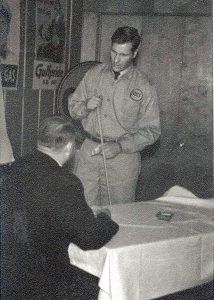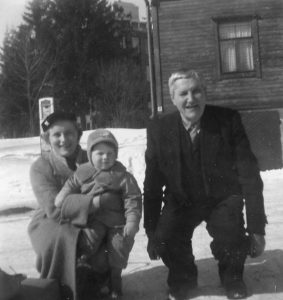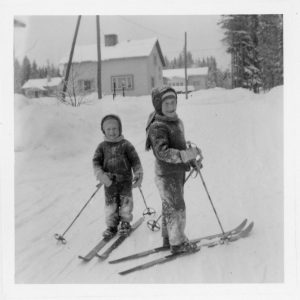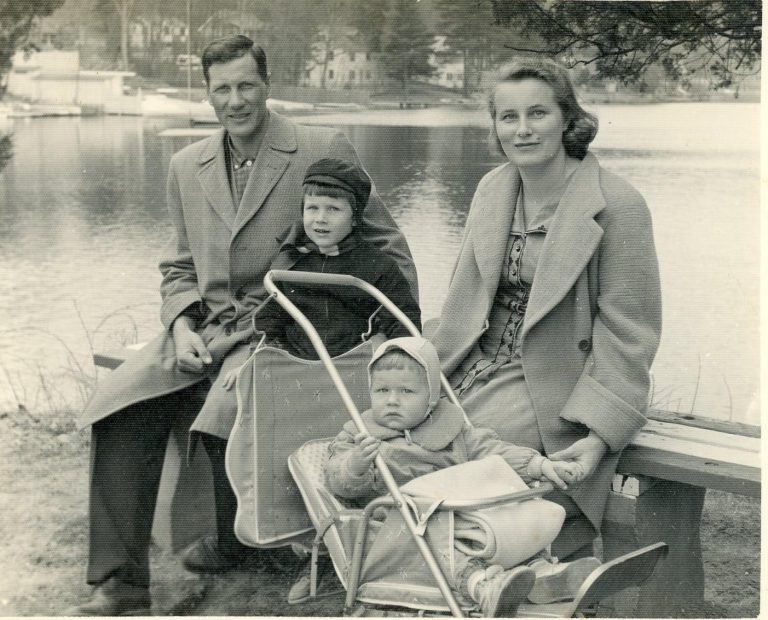Chapter 1 – The American Dream

Just before Dad left Finland he had found some success in the post World War II environment by securing a highly sought after (400 applicants) management position at the Hotel Wien (now known as Hotel Marski) in Helsinki. Even so that success was not enough to quell his desire to see the world and in particular the United States. Most people would be reluctant to take such a bold step but he was a risk taker much like his father Edvard who was audacious enough to build a six story, brick apartment building in Tammelund in the late 1930’s.
On June 18, 1947 he boarded a freighter named the MS Torrens (Norwegian) with his friend Mikko Marto who apparently came up with the idea and made the arrangements. He was 23 years old when he was hired to be a cook (he had taken some courses) and reached ports in Antwerp, Lisbon, Durban and Sydney, Australia before returning through the Suez Canal and Marseilles to Oslo and eventually Stockholm late in the year. The trip was certainly memorable with adventures involving the smuggling of bibles and cigarettes, and his miraculous discovery of a 1923 (his birth year) U.S. Silver dollar while aboard a docked freighter in Townsville, Australia. The coin was found partially embedded in a chunk of iron ore (among tons) and in his mind affirmed his destiny to go to the United States.
On Christmas Day of that year he once again went to sea headed for the western hemisphere and places like Rio de Janiero, the mouth of the Amazon, and Curacao. Lacking proper paperwork he was detained in Curacao and, for reasons that are unclear, was released to go to the United States as he had always intended. He disembarked in New York where he was legally allowed to stay 120 days and immediately went to one of the many Finnish enclaves, otherwise known as Finn towns, in Brooklyn where he began to make valuable contacts that would prove to be very helpful.
He returned to Finland in December 1951 and soon found work at Gulf Oil. Within the next year he met and married Maire Tuulikki Sederholm on August 16, 1952. Tuulikki worked at the Helsingin Sanomat newspaper at the time handling subscription payments and enjoyed it very much.

I was born on August 27, 1953 and for almost two years we lived in one of the third floor apartments in Granddad’s (Edvard) Tammelund apartment building. During that period Dad advanced rapidly at Gulf Oil becoming a service station and dealer trainer until he decided to return to the U.S. in the spring of 1955.

The decision to leave Finland to live in America was a major one especially with the responsibility of a family of his own. Mom never said how she felt about the move but it would prove to be a difficult one for her. Dad was motivated by his positive experiences during his previous stay when he learned the residential roofing and siding trades and came to appreciate the diversity of America through a coast to coast journey visiting Florida and California driving an old Ford that barely functioned. That period from 1949-1951 served to confirm his confidence in the American Dream; the fundamental belief that the United States provides the fewest obstacles for anyone to achieve financial success and upward social mobility provided they are willing to work hard enough.

In those days it was not unusual to make transatlantic trips via ocean liners which certainly made them longer and more exciting than they are now. We left from Turku on the east coast aboard a ship that took us to Stockholm followed by a train trip across Sweden to Gothenburg. There we boarded the ocean liner MS Stockholm which gained notoriety a year later by colliding with the Italian liner, Andrea Doria, resulting in the loss of 46 lives. The disaster could have been much worse had the ship not remained afloat for a day before sinking.

It took about a week to reach the next port in Halifax, Nova Scotia and from there it was on to our final destination, New York City. We entered the harbor sailing past the Statue of Liberty regarding her with the same reverence as the many immigrants to the U.S. before us. I know Dad had film of that but I have yet to find the CD that he had it transferred to. After a couple of days at the Henry Hudson hotel in downtown Manhattan (still there today) we moved on to Levittown, Pennsylvania, a suburb of Philadelphia, where Dad had work waiting for him.

The seven Levittown suburban housing developments named after the Levitt brothers, are historically noteworthy. They helped meet the huge demand for affordable housing by the thousands of GIs returning from World War II. The first was near Hicksville, Long Island where Dad worked during his first visit. That development is well documented in David Halberstam’s book “The 1950’s”. Dad was particularly attracted to the project since workers were paid for what they accomplished instead of hourly rewarding those that worked the hardest. The homes were simple boxy structures essentially built with preassembled components and small enough to allow Dad to do a roof in a day and consequently find some financial security relatively quickly. For the rest of his life he would often tell us with a smile on his face that he had the fastest hammer east of the Mississippi and we had little reason to doubt it.

The development of Levittown, Pennsylvania followed the Long Island project spanning the years from 1952 to 1958 with 17,311 homes built. The assembly line building process had become so refined that at its peak a finished house was produced every 16 minutes! We only spent a couple of months there before moving to Deer Park, Long Island close to the first Levittown but even that did not last long. Soon after we moved about 40 miles up the east side of the Hudson River to the rapidly developing area surrounding Peekskill, where Mom and Dad would remain until retirement.
In hindsight, events unfolded as if they were part of a well thought out strategy. Dad’s first visit was essentially a test which confirmed his belief that the US would indeed provide the opportunity to find success faster than he could by remaining in Finland. During that time he was able to establish valuable connections that led to a sponsor for our entry into the country (one of the Levitts) and made it possible to get off to a running start. He realized that there would be few barriers due to his ability to speak English well, learn quickly and even his Finnish background which knowledgeable people viewed positively. In those early days of the Cold War Finns were admired for their valiant resistance during the Winter War and for rapidly paying off war reparations. Finally, the fact that he was able to pursue a construction trade in economic boom times allowed him to accumulate enough money to become self-employed and enjoy the full fruits of his work.

The place we moved to was a few miles north of Peekskill to a hillside development near the Hollowbrook Drive In Theatre (now an historic site) off of Oregon Road. Soon after my brother and only sibling, Eric Jonathan, was born on August 28, 1956. Interestingly, the actor Mel Gibson, was also born in the same Peekskill hospital earlier that year before moving to Australia. We would make one more move to a basement apartment on Chester Place in Lake Peekskill (a hamlet within Putnam Valley) a couple of miles away before our first return to Finland just before Christmas of 1959.

That trip was memorable and essentially the reverse of the one to New York in 1955. Now a family of four, we boarded the MS Kungsholm for the transatlantic voyage during which we experienced a mechanical breakdown that stranded us for a few hours. We arrived in Stockholm after taking the train from Gothenburg and boarded an icebreaker by the name of the Birger Jarl for the relatively short trip to Turku. During the night the ship hit an islet near Mariehamn with a jolt of sufficient strength to toss me out of my top bunk to the floor. My father immediately equipped Eric and I with life jackets before going to investigate and finding that the damage was not enough to prevent us from resuming the journey.
In Turku we met Dad’s brother Kalevi Edvard who had generously offered to drive us in his new car to the home of my grandparents (mother’s side) in Lohja. The conditions were icy and rounding a sloped bend we started to slide towards the other lane and an oncoming truck. Dad, who was riding in the front passenger seat, shouted for us to get down and miraculously we only suffered a glancing blow and no injuries. The car ended up undrivable so Dad stayed with his brother to sort things out and Mom, Eric and I took a taxi the rest of the way.

We arrived at the Sederholm’s the day before Christmas Eve and stayed until summer. Both Eric and I remember that period fondly. We learned to cross country ski and had our first experiences with saunas. Karl and Katrina Sederholm, known as Vaari and Mummi to us, were a joy to be with and there are many tales to tell about the good times we had.
Their home was located on the corner of Ojamonkatu and Haikarinkatu almost equidistant from the town center and Lohjanjarvi where we spent a lot of time. They had a large yard that was almost totally dedicated to growing fruits and vegetables. You could easily eat your fill picking berries and pea pods. Quite often I was asked to dig up potatoes for dinner. They lived simply using a wood stove and eschewing the modern amenity of a phone.
I never knew much about the history of that side of the family since my Mom rarely spoke about it, but I recently contacted her brother Veli who lives in Södertälje near Stockholm to see what he could tell me. He quickly sent me a general history that I hope to pursue further because it is quite amazing. Apparently the Sederholm family originated in Belgium and emigrated to Sweden and Finland in the 1600s. According to my uncle they established ties with Swedish royalty and the family name became protected making it fairly easy to track ancestors. Of special interest to me was the fact that they were prominent merchants in Helsinki during the last part of the 1700s and most of the 1800s. The Sederholm House (built in1757) on Aleksanterinkatu is the oldest in Helsinki and is now a children’s museum.
A month or so before I was to start second grade in early September we returned to the U.S. I needed to refresh my English very quickly and makeup for the fact that I had missed most of the previous school year. Dad had found us a new home on Lincoln Street off Lake Oscawana Road in Putnam Valley a couple of miles further north of Lake Peekskill and near my school. Lincoln Street is now called Old Stonehouse Road and was probably named after the two unit stone house where we rented the second floor apartment and would finally start a period of relative stability.
